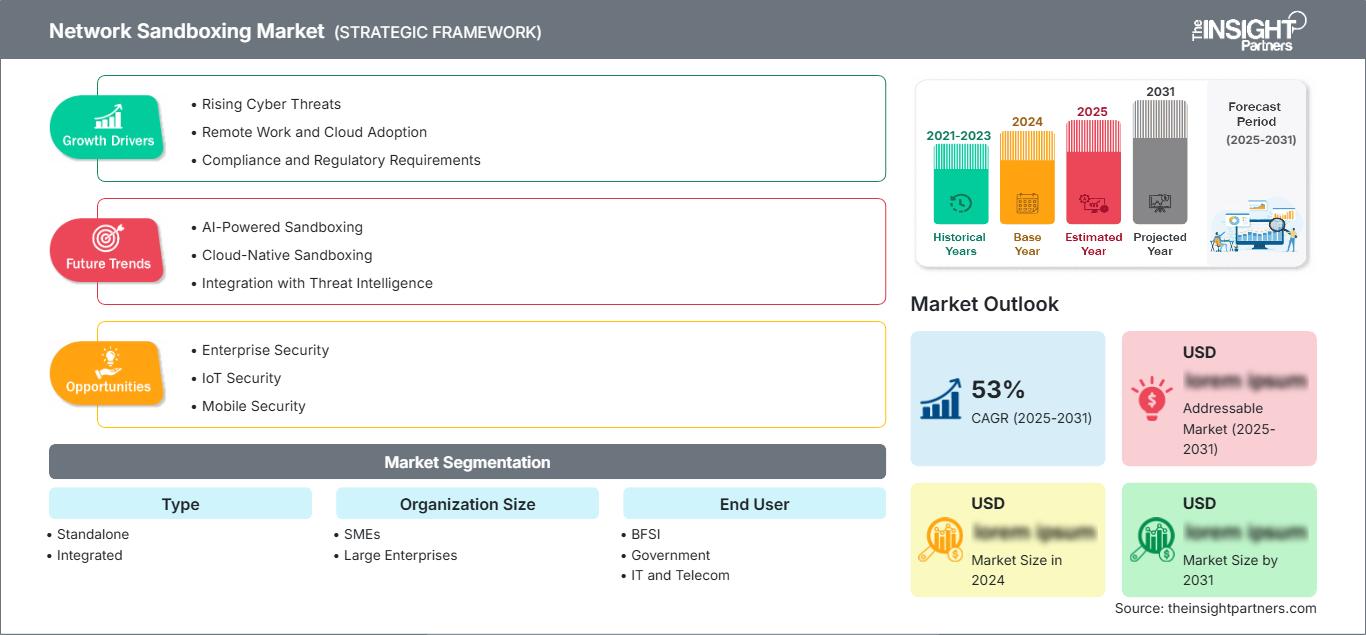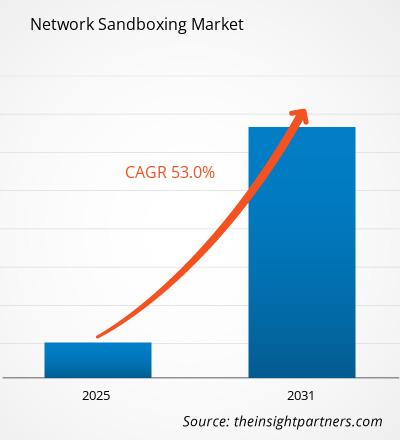The Network Sandboxing Market size is expected to reach US$ 128.31 Billion by 2031. The market is anticipated to register a CAGR of 9.8% during 2025-2031.
The report is segmented based on Type (Standalone, Integrated), Organization Size (SMEs, Large Enterprises) and End User (BFSI, Government, IT and Telecom, Retail, Healthcare, Education, Others). The global analysis is further broken down at the regional level and major countries.
Purpose of the Report
The report Network Sandboxing Market by The Insight Partners aims to describe the present landscape and future growth, top driving factors, challenges, and opportunities. This will provide insights to various business stakeholders, such as:
- Technology Providers/Manufacturers: To understand the evolving market dynamics and know the potential growth opportunities, enabling them to make informed strategic decisions.
- Investors: To conduct a comprehensive trend analysis regarding the market growth rate, market financial projections, and opportunities that exist across the value chain.
- Regulatory bodies: To regulate policies and police activities in the market with the aim of minimizing abuse, preserving investor trust and confidence, and upholding the integrity and stability of the market.
Network Sandboxing Market Segmentation Type
- Standalone
- Integrated
Organization Size
- SMEs
- Large Enterprises
End User
- BFSI
- Government
- IT and Telecom
- Retail
- Healthcare
- Education
- Others
Geography
- North America
- Europe
- Asia-Pacific
- South and Central America
- Middle East and Africa
You will get customization on any report - free of charge - including parts of this report, or country-level analysis, Excel Data pack, as well as avail great offers and discounts for start-ups & universities
Network Sandboxing Market: Strategic Insights

-
Get Top Key Market Trends of this report.This FREE sample will include data analysis, ranging from market trends to estimates and forecasts.
Network Sandboxing Market Growth Drivers
- Rising Cyber Threats: The increasing sophistication of cyberattacks, including advanced persistent threats (APTs), has made network sandboxing a crucial security measure.
- Remote Work and Cloud Adoption: The shift towards remote work and cloud-based services has expanded the attack surface, making network sandboxing essential to protect against threats.
- Compliance and Regulatory Requirements: Stricter data privacy and security regulations are driving organizations to implement robust security solutions, including network sandboxing.
Network Sandboxing Market Future Trends
- AI-Powered Sandboxing: AI and machine learning will enhance sandboxing capabilities by automating threat detection and response processes.
- Cloud-Native Sandboxing: Cloud-native sandboxing solutions will provide scalable and flexible protection for cloud environments.
- Integration with Threat Intelligence: Integrating sandboxing with threat intelligence platforms will enable more accurate threat detection and response.
Network Sandboxing Market Opportunities
- Enterprise Security: Network sandboxing can be a valuable tool for enterprises to protect their critical infrastructure and sensitive data.
- IoT Security: Sandboxing can help secure IoT devices by isolating and analyzing malicious traffic.
- Mobile Security: Network sandboxing can be used to protect mobile devices from malware and other threats.
The regional trends and factors influencing the Network Sandboxing Market throughout the forecast period have been thoroughly explained by the analysts at The Insight Partners. This section also discusses Network Sandboxing Market segments and geography across North America, Europe, Asia Pacific, Middle East and Africa, and South and Central America.
Network Sandboxing Market Report Scope
| Report Attribute | Details |
|---|---|
| Market size in 2024 | US$ XX Billion |
| Market Size by 2031 | US$ 128.31 Billion |
| Global CAGR (2025 - 2031) | 9.8% |
| Historical Data | 2021-2023 |
| Forecast period | 2025-2031 |
| Segments Covered |
By Type
|
| Regions and Countries Covered |
North America
|
| Market leaders and key company profiles |
|
Network Sandboxing Market Players Density: Understanding Its Impact on Business Dynamics
The Network Sandboxing Market is growing rapidly, driven by increasing end-user demand due to factors such as evolving consumer preferences, technological advancements, and greater awareness of the product's benefits. As demand rises, businesses are expanding their offerings, innovating to meet consumer needs, and capitalizing on emerging trends, which further fuels market growth.

- Get the Network Sandboxing Market top key players overview
Key Selling Points
- Comprehensive Coverage: The report comprehensively covers the analysis of products, services, types, and end users of the Network Sandboxing Market, providing a holistic landscape.
- Expert Analysis: The report is compiled based on the in-depth understanding of industry experts and analysts.
- Up-to-date Information: The report assures business relevance due to its coverage of recent information and data trends.
- Customization Options: This report can be customized to cater to specific client requirements and suit the business strategies aptly.
The research report on the Network Sandboxing Market can, therefore, help spearhead the trail of decoding and understanding the industry scenario and growth prospects. Although there can be a few valid concerns, the overall benefits of this report tend to outweigh the disadvantages.
Frequently Asked Questions
What are the options available for the customization of this report?
What are the deliverable formats of the Network Sandboxing Market report?
Which are the leading players operating in the Network Sandboxing Market?
What is the expected CAGR of the Network Sandboxing Market?
What are the future trends of the Network Sandboxing Market?
What are the driving factors impacting the Network Sandboxing Market?
- Historical Analysis (2 Years), Base Year, Forecast (7 Years) with CAGR
- PEST and SWOT Analysis
- Market Size Value / Volume - Global, Regional, Country
- Industry and Competitive Landscape
- Excel Dataset
Recent Reports
Testimonials
Reason to Buy
- Informed Decision-Making
- Understanding Market Dynamics
- Competitive Analysis
- Identifying Emerging Markets
- Customer Insights
- Market Forecasts
- Risk Mitigation
- Boosting Operational Efficiency
- Strategic Planning
- Investment Justification
- Tracking Industry Innovations
- Aligning with Regulatory Trends





















 Get Free Sample For
Get Free Sample For